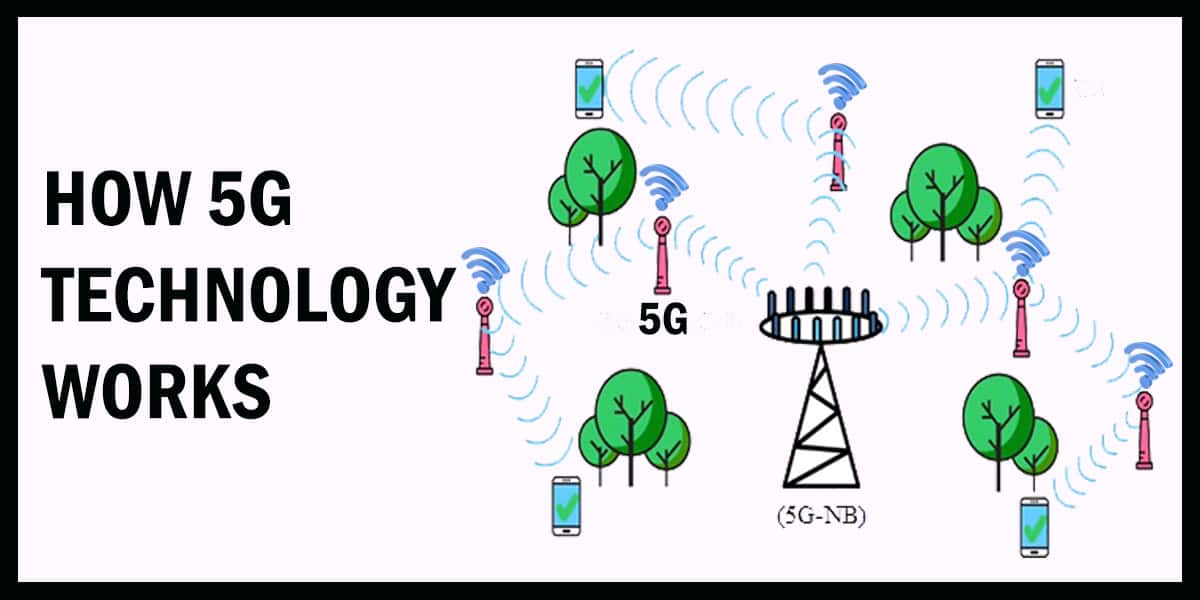What is 5G? How does 5G works?

The year was 2008. There had been talking of Android phones. You yearned for a Moto RAZR while wondering what this gossip about iPhone 3G is. Mobile internet was mostly 2G– and expensive. Fast forward to a couple of years, and phones with touch screens and faster processors were coming out. You prefer the slick aesthetic of the iPhone 5 now, and 4G is the internet network technology that is being used in smartphones. But researchers have developed another network technology which is known as the 5G network! Now, what is 5G?
We have been hearing about 5G technology for quite some time now. How different is it in comparison to 4G? To begin with, the “G” in the name refers to the latest “generation” of wireless technology. Many of the previous mobile network generations have been distinct because of their data transferring speeds.
Let’s Recap
To start from the beginning, a cellular or mobile network consists of areas with stations that make up a communication network. Sounds simple enough, right? Except that the last communicative link of the mobile network is wireless. Areas divided into “cells” have at least one minimum cell site or transceivers known as transmitters or base stations.
With these stations, the “cell” becomes part of network coverage and transmits content like voice calls and other data. A cell usually employs a unique range of frequencies or spectrum to differ from neighboring cells. This prevents interference and maintains the quality of the cell’s service.
Cell phones use radio waves to transmit signals for making calls via a base station or tower. Altogether, cells make a mobile network that covers a large area. Thus, portable devices capable of receiving signals can communicate with each other in the network.
The first or 1G networks were analog cellular technology. 2G followed, with technologies like GSM and CDMA, making up the first digital cellular network technology generation. Next came 3G (UMTS, EVDO, and HSPA) with speeds ranging from 200 kilobits per second (kbps) to several megabits per second (Mbps).
Currently, we have 4G networks, with LTE (or Long-Term Evolution) as the most common. It works on orthogonal frequency-division multiplexing, or OFDM, which splits one data stream over multiple frequencies for faster transmission. 4G networks provide even gigabit (GB) level speeds. Scaling up from 4G, 5G will be much faster than 4G. It will transmit up to 20 Gbps at its peak, and over 100 Mbps on average.
Interesting Read: Top 30 Most Useful Websites to Visit Daily
What is 5G?
5G is the fifth-generation mobile network. It is the latest wireless network with improved technology, speed, and reliability. Compared to 4G and 3G, it has more network capacity, very low latency, and the ability to deliver higher multi-Gbps data speed.
How Does 5G Work?
Working Principle of 5G Technology
Similar to LTE, 5G technology also works on the OFDM (Orthogonal Frequency Division Multiplexing,) principle. In OFDM, the high-speed data is spread and transmitted over a large number of low rate carriers (Ref: Principles of OFDM – https://link.springer.com/chapter/10.1007/978-0-387-68192-4_4
A 5G network also uses a cell site network and relays data via radio waves like other generations of cellular networks. However, compared to LTE, the air interface of 5G operates on increased flexibility and lowers the latency.
The latter means there will be shorter delays before data transmission begins, making for a faster experience. The more efficient encoding design translates into roughly 30 percent improved speeds despite using the same airwaves as 4G.
This works by fitting 5G to work with larger channels than the ones used by 4G. While 4G frequency channels are largely 20 MHz (combined into 160MHz), 5G channels go all the way up to 100MHz. Now at this point, the short-distance higher millimeter-wave frequencies are necessary.
While other networks like 4G or television stations occupy lower frequencies, there are plenty of vacant higher frequencies available around the world for 5G technology. Think of these as large “roads” made for network carriers’ high-speed internet.
The average 5G network requires smarter designing to handle increasing cells – possibly with wider bandwidths and enhanced antennas. 5G aims for higher speeds and capacity per area, all at much lower latency. For the average home user, it means increased capacity, better upload/download speeds, and connecting more devices.
Low, Middle, and High 5G Bands
When it comes to airwaves, 5G provides mobile network carriers with more options than 4G. As the 5G network can operate on all frequencies (spectrum), the experience boils down to the number and width of channels.
• Low-Band 5G Spectrum
It works with frequencies under 1GHz. As the oldest available telecommunication frequencies, they have greater coverage. However, the channels are narrower, with most operating 4G. The Low-band spectrum has slower speeds with carriers running an average of 10 MHz in width. To be more accurate, it is like 4G for now.
• Mid-Band 5G Spectrum
This spectrum operates in a range of 1 to 10 GHz. This includes most mobile and Wi-Fi frequencies, along with those frequencies slightly higher.
• High-Band 5G Spectrum
This is the latest 5G network, including airwaves from 20-100 GHz. However, it has the least coverage. Currently, low-band 5G is not compatible with high-band, so you won’t find phones capable of handling both yet! The first crop of 5G-supporting phones works with either one or the other 5G system.
To wrap things up, the move to 5G technology will certainly transform the way we work with technology every day. The move to 5G will not happen overnight, as things still need smoothing out. Whether at work or play, faster broadband speeds and higher user capacity will benefit everyone. 5G technology is at last transforming into reality after nearly a decade of development.
Note: Does this article provide the info you’re looking for? Is there any information you think of missing or incorrect? You can give your opinion in the comments section below.
If you like this tutorial, share this post and spread the knowledge by clicking on the social media options below because “Sharing is caring”
Sources:






